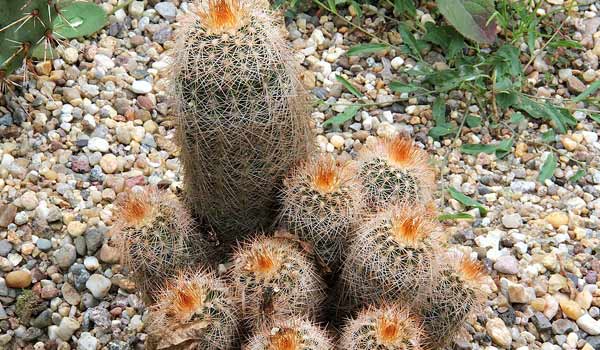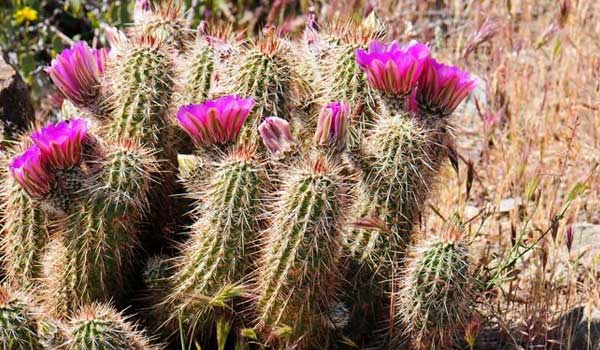Hedgehog Cactus Care (Full Guide)

The hedgehog cactus is best for those cacti enthusiasts that prefer slow-growing species of the succulents’ world. There are different hedgehog cactus species, and all are great candidates for your garden or indoor spaces.
In this post, we’ll talk thoroughly about this cute plant, how it looks, its flower and fruit, as well as hedgehog cactus care and propagation.
About the Hedgehog Cactus
The hedgehog cactus scientific name is Echinocereus viridiflorus; or simply Echinocereus after its genus.
It gets its common name from its short and spiny stems that look like a hedgehog (its spiny fruits may be the reason as well). Sometimes it is also referred to as Engelmann’s hedgehog cactus, after the botanist and physician George Engelmann.
Some also call it the porcupine hedgehog cactus, as the word “echinos” means porcupine in Greek. “Cereus” also means candle, referring to its shape.
Echinocereus has a cylindrical body covered with up to 14 ribs. In its natural habitat (mainly southwestern United States and Mexico), this plant usually grows in clusters. As the plant matures, it loses its erect shape and the stem base lies on the ground. Each stem grows up to 25 inches in height and 1.5 to 3.5 inches in diameter.
It is also covered with heavy and tough spines. You can see that the spines on the hedgehog cacti have different shapes and colors. The radial ones are short and needlelike; the central ones are usually angular, and their colors vary from white and bright yellow to grey and dark brown.

Hedgehog Cactus Flower
The hedgehog cactus species have beautiful bright magenta (or other shades of pink) blooms that appear in April to late May depending on the climate.
They bloom at almost the top of the stem and grow up to 3 inches in diameter with dark-green stigmas. Therefore, the hedgehog cactus flowers look quite large compared to the stem sizes.
The blooms are open at day and closed at night. Although eye-catching, they only live for about a week and are not fragrant.
Hedgehog Cactus Fruit
When the Echinocereus flowering is over, the orange-red hedgehog cactus fruits will appear. These fruits have a spherical to ovoid shape and are covered with spines.
When the fruits mature and reach 1 inch in length, they will fall off and you can enjoy its fleshy white pulp. And that is when the birds and rodents start eating them in the wild.
Interestingly, this plant is also called strawberry hedgehog cactus due to the strawberry-like taste of the fruits.
Hedgehog Cactus Species
Echinocereus species can be divided into two groups:
One: the flowering species with purple-red to pink-purple blooms like:
- Echinocereus scheerii
- Echinocereus salmianus
- Echinocereus berlandierii
- Echinocereus pectinatus or the rainbow cactus
- Echinocactus grusonii or the well-known golden barrel cactus
Two: the globular species that are best known for their spines such as:
- Echinocereus pulchellus
- Echinocereus subinermis
- Echinocereus knippelianus
- Etc.
You should know that the latter group also bloom, and produce white, pink-white to grey-blue flowers.

Hedgehog Cactus Care
Hedgehog cactus care is quite simple. It needs no special grooming and maintenance, and its requirements are pretty common:
- Water: Different hedgehog cactus species have different water needs. If you have a spiny variety, don’t water it too often even in summer. They are very sensitive to overwatering and root rot would be a serious problem. But if you have a less spiny species, you can water more frequently (every two weeks for example). But still,to let the soil dry out before each irrigation.
- Soil: To be successful in hedgehog cactus care, don’t forget to provide it with an ideal potting mix. Echinocereus can handle rich soils, but we recommend using regular cactus soil.
- Light: The porcupine hedgehog cactus loves the sun. So place it in a spot with as much light as possible such as western facing-windows. When placed in full sun (6 to 8 hours), water properly so it thrives with no problem.
- Temperature: Providing this plant with the right temperature is essential in hedgehog cactus care. So during the cold months in the winter, place it in a cool and frost-free location with enough light as temperatures lower than 50 degrees Fahrenheit can cause some problems.
- Feeding: Similar to watering, hedgehog cactus species have different requirements. To help your plant’s growth, in the summer months, apply a regular dose of diluted cactus fertilizer.
- Repotting: Every year or so and only when your plant outgrows its container, move it to a new pot. It has a shallow root system, so be very careful not to damage it when transplanting.
- Pests and Diseases: Always keep an eye for pest or disease problems in hedgehog cactus care such as scale insects and mealy bugs. If infected with these pests, carefully remove them using a toothpick and wipe the plant down. In case of root mealy bugs, change the potting mix and water with an insecticide to prevent attacks in the future.
Hedgehog Cactus Propagation
You can propagate this cute plant using both hedgehog cactus seeds and cuttings:
- To propagate using seeds, simply plant the seeds in a sandy seedbed or prepared containers in spring or summer. Place in a warm location and keep moist until it germinates.
- To propagate with cuttings, remove an offset in the summer and let it dry out for a few days. Then, plant it in a moist cactus potting mix and place it where it can receive full sunlight. Keep it warm and moist until it develops roots. Be patient, it may take up to two weeks.
Happy cultivating!
- In this post:
- About the Hedgehog Cactus
- Hedgehog Cactus Care
- Hedgehog Cactus Propagation



